The results of a new distal protection method in intervention for chronic total occlusion of the superficial femoral artery
- PMID: 19946634
- PMCID: PMC2778189
- DOI: 10.4061/2009/687609
The results of a new distal protection method in intervention for chronic total occlusion of the superficial femoral artery
Abstract
Aims. To determine the efficacy of a new distal protection method in SFA CTO interventions. Methods and Results. From June 2003 to February 2009, ninety-two consecutive, chronic total occlusions of superficial femoral arteries were treated with catheter-based intervention using a bidirectional approach. Nine of these cases were managed with our original, distal protection method, based on symptoms, angiographic images, wire resistance, and intravascular ultrasound images. The average age was 73 years; eight patients were male. The mean occlusion length was 17.1 cm. A distal protection balloon was inserted from the retrograde sheath in the popliteal artery and placed distal to the occluded lesion after successful wire crossing. Lesion dilatation with a balloon was performed antegradely and debris was removed by 6Fr. guiding catheter. Debris was retrieved from all lesions, consisting mainly of thrombus. Where we decided not to use the distal protection method, there was no distal thromboembolism. Conclusion. In SFA-CTO intervention, the risk of distal embolization is 10%, which can be anticipated and eliminated by the distal protection method.
Figures
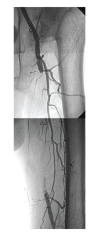


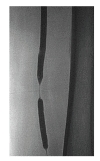
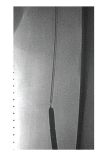
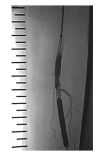
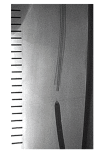
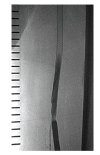



Similar articles
-
Retrograde Popliteal Access and Balloon Dilatation of Chronic Total Occlusion of Superficial Femoral Arteries.Ann Vasc Surg. 2020 Apr;64:253-262. doi: 10.1016/j.avsg.2019.09.030. Epub 2019 Oct 18. Ann Vasc Surg. 2020. PMID: 31634601
-
Retrograde recanalization technique for use after failed antegrade angioplasty in chronic femoral artery occlusions.J Endovasc Ther. 2012 Feb;19(1):23-9. doi: 10.1583/11-3645.1. J Endovasc Ther. 2012. PMID: 22313197
-
Retrograde popliteal approach for challenging occlusions of the femoral-popliteal arteries.J Vasc Surg. 2013 Jul;58(1):84-9. doi: 10.1016/j.jvs.2013.03.038. J Vasc Surg. 2013. PMID: 23806253
-
Incidence and clinical significance of distal embolization during percutaneous interventions involving the superficial femoral artery.J Vasc Surg. 2007 Dec;46(6):1155-9. doi: 10.1016/j.jvs.2007.07.058. J Vasc Surg. 2007. PMID: 18154991 Clinical Trial.
-
Chronic Total Occlusion Wiring: A State-of-the-Art Guide From The Asia Pacific Chronic Total Occlusion Club.Heart Lung Circ. 2019 Oct;28(10):1490-1500. doi: 10.1016/j.hlc.2019.04.004. Epub 2019 Apr 25. Heart Lung Circ. 2019. PMID: 31128985 Review.
Cited by
-
Use of embolic protective devices in treating acute arterial occlusions: an interventional radiology and vascular surgery collaborative learning experience.BMJ Case Rep. 2013 Apr 10;2013:bcr2012008132. doi: 10.1136/bcr-2012-008132. BMJ Case Rep. 2013. PMID: 23580669 Free PMC article.
References
-
- Grube E, Gerckens U, Yeung AC, et al. Prevention of distal embolization during coronary angioplasty in saphenous vein grafts and native vessels using porous filter protection. Circulation. 2001;104(20):2436–2441. - PubMed
-
- Baim DS, Wahr D, George B, et al. Randomized trial of a distal embolic protection device during percutaneous intervention of saphenous vein aorto-coronary bypass grafts. Circulation. 2002;105(11):1285–1290. - PubMed
-
- Yip H-K, Wu C-J, Chang H-W, et al. Effect of the PercuSurge GuardWire device on the integrity of microvasculature and clinical outcomes during primary transradial coronary intervention in acute myocardial infarction. American Journal of Cardiology. 2003;92(11):1331–1335. - PubMed
-
- Mizote I, Ueda Y, Ohtani T, et al. Distal protection improved reperfusion and reduced left ventricular dysfunction in patients with acute myocardial infarction who had angioscopically defined ruptured plaque. Circulation. 2005;112(7):1001–1007. - PubMed
-
- Umeda H, Iwase M, Izawa H, et al. Is it possible to predict which patients need distal protection during primary angioplasty? International Journal of Cardiology. 2008;127(2):179–185. - PubMed
LinkOut - more resources
Full Text Sources
